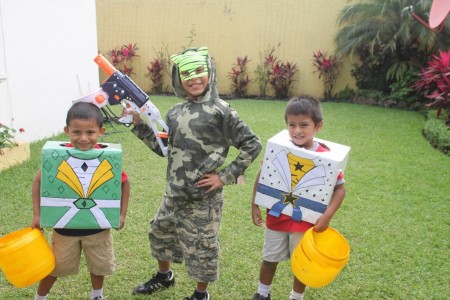Suppose, however, for the sake of argument, that you decide your child is being bullied.
There are three main tools to teach your child how to avoid being bullied. The first is the tried and true “ignore it” and turn or move away from the bully. If that doesn’t work, the child should be encouraged to tell the bully to “Stop!” Finally, the third tool is to get help from a trusted adult, such as a teacher or a parent.
However, as we attempt to identify procedures to deal with bullying, we right away run into a problem. Is bullying the same in all age groups? I think we would all agree that it is not. The definition I offered describes behavior that “has at its core the intention to harm or intimidate”. While this is true in the most experience-near sense – that is, the behavior seems designed to produce that result – it is not at all clear that the preschool child has the conscious intention to “harm or intimidate”. Usually, when I speak to even older children of school age, they will explain that the other child, the victim, was “annoying” them, or something like that. In other words, although nonsensical to the observing adult, the bully often really believes that the other child is the provocateur. For example, I observed a 5-yo boy telling another child that he was a baby, while puffing up his chest and looming over him in a way that clearly intimidated his classmate. When challenged by the teacher about his behavior, the boy claimed that his classmate had “lied” to him about being older than he. Of course, this seems ridiculous to an adult, so let’s take it apart and see if we can understand it better. In doing so we are engaging in the other extremely important approach to bullying – understanding the mind of the child.
In order to find a lasting solution to bullying – bullying of your child and bullying in a community such as a classroom – we need to answer the question of why children bully.
To answer this question, let’s consider three kinds of bullies – the group bully, the “reactive bully”, and the long-term, or chronic, bully.
Probably the easiest bully to understand is the “group bully”. This bully is a child who is attracted to a powerful peer and joins a group attack on another child. This is a terrible experience for the bullied child, because there is nothing more frightening than being confronted by a hostile crowd. Often the group bully is ambivalent about the bullying behavior and quietly ashamed of her participation in it, yet is afraid to challenge the powerful leader.
The second kind of bully is the “reactive bully”. In simple terms, this bully feels wounded, wronged by the world, and takes his out his anger and frustration on someone else. The source of his hurt may be short lived, such as feelings about the birth of a younger sibling. Or, it may be long lasting, such as the enduring threat caused by chronic illness, an alcoholic parent, or by domestic violence. A common cause of this kind of bullying is severe marital conflict or divorce. It is important to realize that a child does not have to “learn” bullying behavior in the home. Preschool children are not cognitively mature enough to understand that their hurt feelings from family problems are motivating their aggressive behavior towards peers. When a young child behaves this way in response to family stress, the bullying behavior usually resolves when the family stress improves or in response to an empathic adult’s attention – for example, a teacher. However, it is also true that if a parent assumes a bullying stance, for example talking aggressively about what he will do to a neighbor if he keeps putting his trash barrels on their side of the driveway, children will often identify with the parent and his behavior.
The third kind of bully is a chronic bully. There are no chronic bullies in preschool. It takes longer than that to create a chronic bully. Chronic bullies are the tragic consequence of children brought up in high stress environments in which they themselves feel bullied.
Let’s consider responses to each kind of bully. In each case, the best first response is to collaborate with the teacher and other school personnel. The teacher can be present when you are not there to protect your child. If you think that bullying is going on when the teacher is not looking, then bring this to his or her attention. The first goal of the collaboration should be to stop the bullying immediately. An adult must step in to protect the victim of the bullying if he cannot protect himself. The next step is to prevent future bullying. In the case of the group bully, that means diminishing the power of the leader through non-punitive confrontation with the bullying behavior, appropriate consequences, and talking separately to the members of the group so that you support each child’s behaving like his or her best self. In the case of the reactive bully, it means identifying the source of the bullying child’s distress, making the link for him (“When you are hurting so badly sometime you think it will make you feel better to make someone else hurt.”), and trying to make his home environment better. In the case of the “chronic” bully, professional help is definitely needed.These children need psychotherapy to provide them with the kind of trusting relationship in which they can face their fears of isolation or injury and find more adaptive ways of coping than frightening other children.
In my next blog posting, I will discuss the most substantial, long-term solution to “bullying”.

